Lowrance electronic HDS-5, HDS-7 User Manual

988-0176-01B
HDS-5 & HDS-7
Fish Finding Sonar and GPS
Operations Guide
Software updates for your unit.
Occassionally check the Lowrance website for free software upgrades for your unit. Go to www.lowrance.com for the software upgrades. Select the Downloads option from the grey menu bar near the top of the Lowrance website homepage. The Downloads screen will appear. Select Products Software Updates from the list on the left side of the screen. The Products Software Updates screen will appear. Scroll through the Product list and select your unit to download the software update.

|
Contents |
Table of contents |
|
Introduction........................................................................................ |
5 |
Getting Started................................................................................. |
7 |
Turning on the Unit..................................................................................... |
7 |
Keypad........................................................................................................ |
7 |
Backlight..................................................................................................... |
7 |
Cursor......................................................................................................... |
7 |
Language.................................................................................................... |
7 |
Menus......................................................................................................... |
8 |
Selecting Chart Data ................................................................................. |
8 |
Selecting a Fishing Mode........................................................................... |
9 |
Entering Letters in Text Boxes.................................................................... |
9 |
Restore Defaults....................................................................................... |
10 |
Pages............................................................................................... |
11 |
Pages Screen........................................................................................... |
11 |
Data Overlay............................................................................................. |
12 |
Configuration menu.................................................................................. |
16 |
Sonar Page............................................................................................... |
17 |
Chart Page............................................................................................... |
17 |
Radar Page............................................................................................... |
18 |
Info Page.................................................................................................. |
18 |
Utilities...................................................................................................... |
23 |
Displaying Combo Pages......................................................................... |
25 |
Sonar Operation............................................................................. |
29 |
Viewing Sonar History.............................................................................. |
29 |
Sonar Menu.............................................................................................. |
30 |
Sonar Options........................................................................................... |
33 |
Palette...................................................................................................... |
34 |
Log Sonar Data........................................................................................ |
36 |
1

Contents |
|
Chart Operation............................................................................... |
39 |
Chart menu............................................................................................... |
40 |
Waypoints................................................................................................. |
42 |
Routes...................................................................................................... |
47 |
Trails......................................................................................................... |
51 |
Measuring Distances on Chart page........................................................ |
54 |
Search by Coordinates............................................................................. |
54 |
Find Chart item......................................................................................... |
54 |
Map Orientation........................................................................................ |
55 |
Look Ahead.............................................................................................. |
55 |
Chart categories....................................................................................... |
56 |
Navionics.................................................................................................. |
58 |
Radar Operation............................................................................. |
61 |
Radar menu.............................................................................................. |
61 |
Cursor position window............................................................................ |
67 |
Radar Overlay.......................................................................................... |
67 |
Settings Menu.................................................................................. |
69 |
Chart Settings Menu................................................................................ |
76 |
Sonar Settings Menu................................................................................ |
79 |
Manual Mode............................................................................................ |
80 |
Fishing Modes ......................................................................................... |
81 |
Installation Menu...................................................................................... |
82 |
Keel Offset................................................................................................ |
82 |
Radar Settings Menu................................................................................ |
86 |
Fuel........................................................................................................... |
93 |
Alarms...................................................................................................... |
97 |
Trails......................................................................................................... |
99 |
Units........................................................................................................ |
100 |
Network.................................................................................................. |
101 |
Vessels................................................................................................... |
108 |
Simulator................................................................................................ |
110 |
2

|
Contents |
Specifications................................................................................. |
113 |
Unit Care.......................................................................................... |
114 |
Troubleshooting.............................................................................. |
115 |
Index................................................................................................ |
123 |
3

Contents
Blank page
4

Introduction
Introduction
Thank you for purchasing from Lowrance, the industry leader in marine technology. This manual is packaged with a Quick Start Guide, Installation Guide, License and Warranty booklet and NMEA 2000 Networks Installation Instructions. If any of these documents are missing, you may acquire them via a free download at www. lowrance.com or by contacting customer service.
Lowrance Customer Service
12000 E Skelly Dr
Tulsa, OK 74128
(800) 324-1356
Canada (800) 661-3983 or (905) 629-1614
About this manual
This manual documents how to adjust features and options in your display unit. The information in each section follows the same sequence as your display unit’s menus. If you would like information on how to get the most out of your unit, visit our web site, www.lowrance.com; click on the Support tab and select Tips and Tutorials.
Manual Conventions
When you are instructed to press a button in this manual, the button will be shown in all caps and bold text like — Menu, Exit, Enter, etc. If you are instructed to select an item from a menu, the item to be selected will be listed in bold like —
Brightness, Key beeps, etc.
For example: Press Menu, select Language and press Enter.
WARNING: When a GPS unit is used in a vehicle, the vehicle operator is solely responsible for operating the vehicle in a safe manner. Vehicle operators must maintain full surveillance of all pertinent driving, boating or flying conditions at all times. An accident or collision resulting in damage to property, personal injury or death could occur if the operator of a GPS-equipped vehicle fails to pay full attention to travel conditions and vehicle
operation while the vehicle is in motion.
5

Introduction
Lowrance HDS-5 and HDS-7
ZOUT: Zoom out to see more of the map with less detail
ZIN: Zoom in to see less of the map with more detail
MOB: Pressing ZOUT and ZIN at the same time will set a man overboard waypoint
KEYPAD: move the cursor, scroll through menus, adjust features, view sonar/GPS history
EXIT: cancels entries, closes menus & windows; toggles between cursor position and chart location on Chart page
MENU: opens context & settings menus
WPT/FIND: saves a waypoint at current position; accesses searching tools
ENTER: finalize menu selections; shortcut key for functions like saving a waypoint at cursor position
PAGES: opens Pages menu; selects active panel for combo display
LIGHT/POWER: controls backlight level & turns the unit on/off
MMC/SD Card slot: insert
MMC/SD and high-detail mapping cards here
6
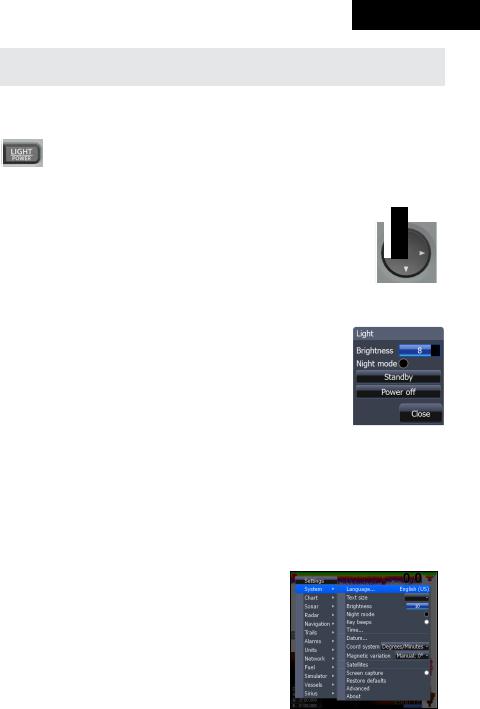
Getting Started
Getting Started
Turning on the Unit
Press the Power/Light key to turn on the unit. If the unit is not connected to a transducer, the unit will start up in simulator mode. To turn off the unit, press the Power/Light key for three seconds.
Keypad
Keypad
This unit’s keypad can be used in two ways. Pressing the arrow symbols on the keypad will move the cursor in the corresponding direction on the screen and allow you to scroll through menus.
Backlight
Tap the Light/Power key to make adjustments to the backlight level and open the Backlight Menu. To turn on Night Mode from the menu, highlight Night Mode and press enter. Night mode optimizes the display for low light conditions.
Cursor
Use the unit’s keypad to move the cursor around the display, select onscreen objects, highlight data items and view sonar history. Press Exit to remove the cursor from the screen.
Language
Selects language used for menus, text boxes and messages.
To select a language:
1.Press Menu twice.
2.Select System and press ENTER
3.Highlight Language and press ENTER.
4.Use the keypad to select a language and press ENTER.
7
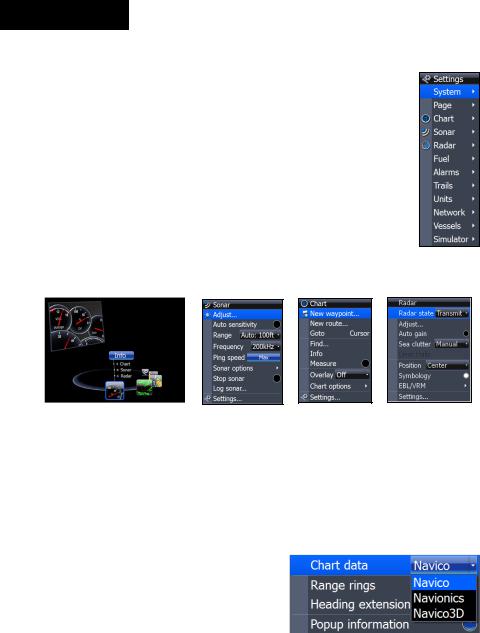
Getting Started
Menus |
|
|
This unit has a Settings menu, a Pages screen and several context |
|
|
menus. The Settings menu provides access to the settings menus for |
|
|
the three main operation modes: Sonar, Chart and Radar. The Settings |
|
|
menu is accessed by pressing MENU twice. |
|
|
The Pages screen allows you to select a page to be shown on the |
|
|
display. Utilities are also accessed from the Pages screen. Press the |
|
|
PAGES key to select a page. |
|
|
Each page has its own context menu which allows you to access |
|
|
functions for that page. Context menus are accessible only when its |
|
|
corresponding page is displayed. The Sonar Menu, for example, will |
|
|
only be available when the Sonar Page is on the display. To access a |
Settings |
|
context menu, select the desired page and press the MENU key. |
||
menu |
Pages screen |
Sonar menu Chart menu |
Radar menu |
Closing Menus
Press the EXIT key to close a menu. Repeatedly pressing EXIT will close all menus, taking you back to the main screen.
Selecting Chart Data
This unit supports three types of map data: Navico, Navionics and Navico 3D (US only). To use Navionics or Navico 3D data, you must select it from the Chart Data menu.
To select Chart data:
1.Press Menu twice.
2.Highlight Chart and press Enter.
3.Select Chart Data and press enter.
4.Select the desired map data option and press enter.
8

Getting Started
Selecting a Fishing Mode
Fishing modes enhance the performance of your unit by providing preset packages of sonar settings geared to specific fishing conditions.
To select a fishing mode:
1.Press Menu twice.
2.Select Sonar and press enter.
3.Highlight Fishing Mode and press enter.
4.Select the desired fishing mode and press enter.
|
Fishing Mode Options |
|
General Use |
Bottom brown/blue background; 50% ping speed |
|
Shallow Water |
Bottom brown/white background; best suited for |
|
depths less than 100 feet |
||
|
||
Fresh Water |
Bottom brown/white background; 50% ping speed |
|
Deep Water |
Deep Blue; 50% ping speed; 50kHz is primary |
|
transducer frequency |
||
|
||
Slow Trolling |
Bottom brown/white background; 50% ping speed |
|
|
|
|
Fast Trolling |
Bottom brown/white background; slightly lower chart |
|
speed |
||
|
||
Clear Water |
Bottom brown/white background; 50% ping speed |
|
Brackish Water |
Bottom brown/blue background; higher ASP; slightly |
|
lower chart speed |
||
|
Entering Letters in Text Boxes
This unit has some features and functions that may require you to enter data in a text box.
To enter data in a text box:
1.HighlightthetextboxandpressENTER. A keyboard will appear on the screen.
2.Use the keypad to highlight the first character and press ENTER. Repeat this step until all characters have been entered.
3.Highlight OK and press enter.
Keypad button controls uppercase & lowercase
Keyboard window
9
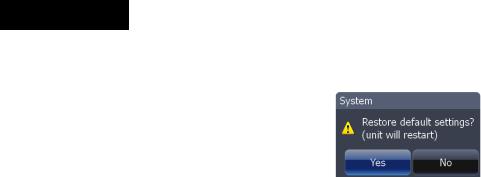
Getting Started
Restore Defaults
The Restore Defaults command switches the unit back to the settings it had when you purchased it (default settings),
To Restore Defaults:
1.Press Menu twice.
2.Select System and press enter.
3.Highlight Restore Defaults and press Enter.Aconfirmationmessage will appear.
4.Select Yes and press enter.
10
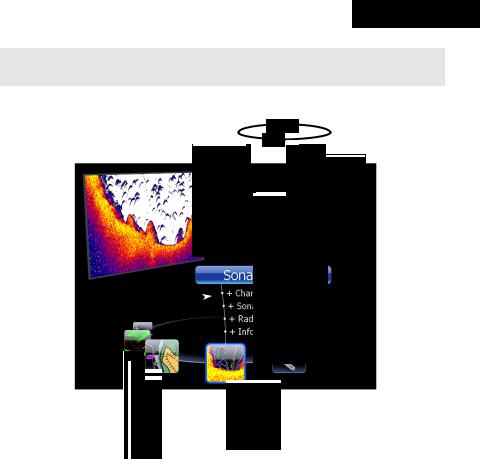
Pages
Pages
With Sonar selected, unit will display a full sonar screen
Combo display
display
options allows you to display a split screen
Page icons rotate around the circular Pages menu
Sonar icon rotated to center of Page Icons page; has blue border indicating
it is the selected page option
Pages Screen
Consists of four page icons that scroll horizontally around the Pages menu. To view the pages screen, press the Pages key.
Selecting Pages
Pressing the keypad left or right will move the page icons around the menu. To select a page, move the desired page icon to the center of the screen.
When selected, the page name will be highlighted in blue at the top of a list of combo display options. Its icon, will be framed by a blue border below the list. To display the page, press ENTER.
11
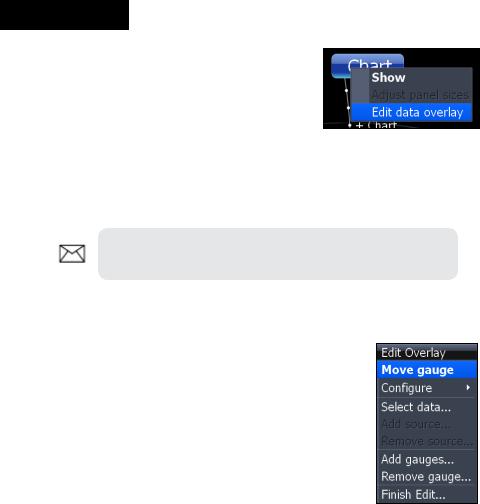
Pages
Data Overlay
Data overlay is information you can display on top of the page screen, allowing you to customize each page with desired data.
Data Overlay menu
Every page option has its own Data Overlay menu. The menu allows you to edit, add or remove overlay data from the display. To access Data Overlay menu, select a page option and press menu.
NOTE: Adjusting Panel Sizes is covered later in this section in the Displaying Combo Pages segment.
Edit Overlay menu
Accesses data overlay options for all the unit’s page screens.
To access Edit Data Overlay menu:
1.Select Edit Data overlay from the Data Overlay menu and press enter.
2.Press Menu.The Edit Overlay menu will appear with Add Gauge selected.
Edit Overlay menu
12
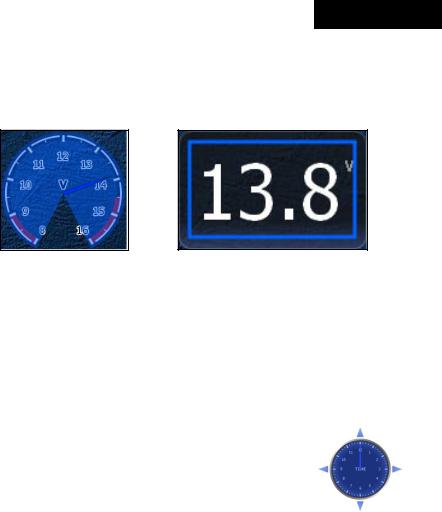
Pages
Edit Mode
When a gauge is added to the display it will be shown in edit mode. Analog and bar gauges are shaded in blue when they are in Edit Mode. Digital Gauges will be shown with a blue border.
Analog gauge in edit |
Digital gauge in edit mode |
mode |
|
Move or Placing a Gauge
The Move gauge command allows you to move data overlay to any position on the screen. When you use the Place gauge command, the gauge will be locked in its current position.
To move or place a gauge:
1.Press the Enter key when the gauge is in Edit mode. Four directional arrows will appear when the gauge can be moved.
2.Use the keypad to move the gauge to a desired location on the screen.
3.Press Enter to place the gauge.
Select Data
Used to select data that will be shown on the data overlay display. When selecting data you first will open a main data category and then choose data to be displayed from the a data subcategory.
13
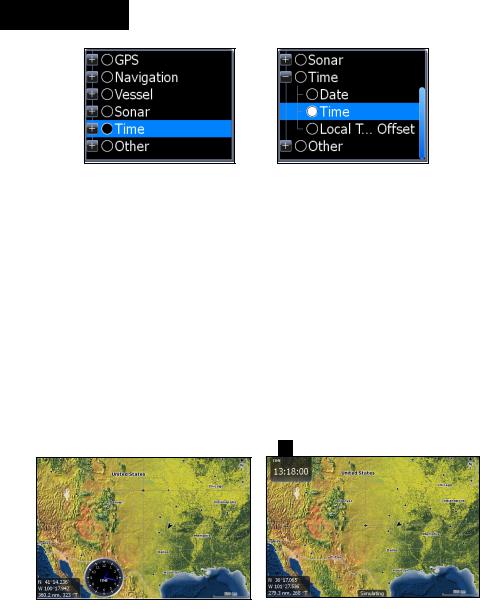
Pages
Select data menu |
Time subcategory |
To select data overlay:
1.Press the Select data softkey. The Select Data menu will appear.
2.Use the keypad to select the desired category and press enter.
A list of subcategories will appear.
3.Select the desired subcategory and press enter.
Type
Switches data overlay display between analog, digital and bar gauge formats, provided the format is appropriate for the selected data type.
To change Type press the Type softkey to toggle between digital and analog gauge formats.
 Time in digital format
Time in digital format
 Time in analog format
Time in analog format
Size
Selects the size of the data overlay display. Data overlay can be displayed in four sizes.
With the gauge in edit mode (shaded in blue) press the Zoom out key to increase overlay size; press the Zoom in key to decrease overlay size.
14
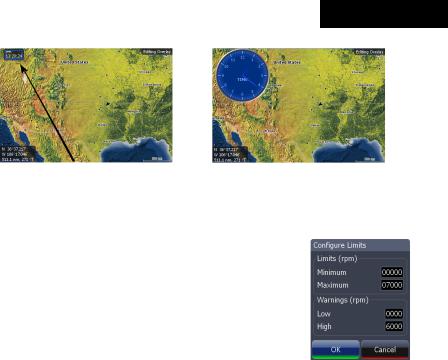
Pages
|
|
|
|
|
|
|
|
|
|
|
Small digital gauge |
Large analog gauge |
||
Limits
Controls the number scale used on data overlay gauges and selects warning thresholds. Changing the limits on an analog or bar gauge removes unnecessary numbers from the gauge, making them easier to read. Warnings help you stay within selected warning thresholds.
Limits are configured by inputting analog or bar gauge limits in the Limits text boxes — minimum and maximum. Warnings thresholds are entered in the Low and High text boxes.
To configure limits:
Configuration
Limits menu
1.Press the Limits softkey. The Configuration Limits menu will appear.
2.Select the Limits or Warnings text box and press enter.
3.Use the keypad to enter the desired threshold.
4.Select OK and press enter.
To save changes:
1.Press Menu and highlight Save.
2.Press enter.
15
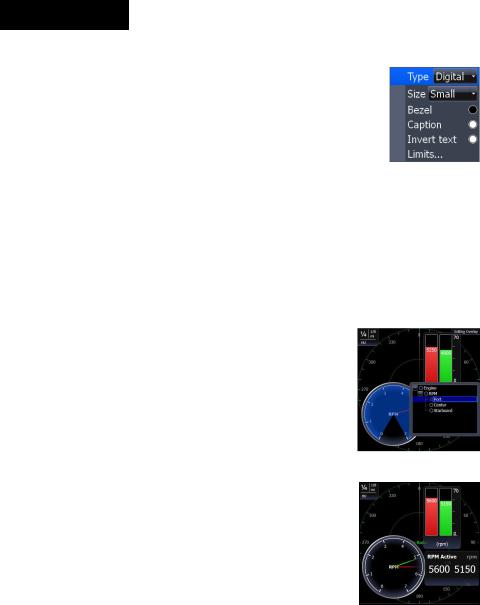
Pages
Configuration menu
Allows you to Add/Remove sources and adjust Bezel, Caption and Invert Text Settings. Other configuration menu options are covered previously in the section.
To access the Configuration menu, highlight Configuration on the Edit Overlay menu and press enter.
|
Configuration Settings |
|
|
Bezel |
Adds a bezel to the data overlay gauge, making it easier to |
||
see against certain backgrounds |
|
||
|
|
||
Caption |
Allows you to add/remove data label from gauge |
||
Invert Text |
Changes appearance of data overlay text |
|
|
Add Source |
|
|
|
Displays the same type of data from different sources on |
|
|
|
the same analog gauge. |
|
|
|
If, for example, you have multiple engines, you could |
|
|
|
select port engine RPM as your data type and then display |
|
|
|
starboard engine RPM using the Add source command. |
|
|
|
Both data sources could be displayed simultaneously on |
|
|
|
an analog gauge with two needles; one dedicated to each |
|
|
|
|
Add Source menu |
||
source. |
|
|
|
|
|
|
|
To use Add Source:
1.Select Add Source from the Edit Overlay menu and press enter. The Add source menu will appear.
2.Highlight a category a press enter. A list of subcategories will appear.
3. Select the desired subcategory and press |
Analog gauge |
|
showing RPM from |
||
enter. |
||
two engines. |
||
|
To remove add source data:
1.Highlight Remove source from the Edit Overlay menu and press enter. A list of sources will appear.
2.Select the source you want to remove and press enter.
16
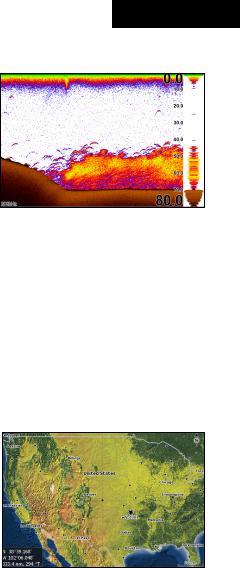
Pages
Sonar Page
Displays the water column moving from right to left on your unit’s screen. On the right side of the screen, the Amplitude Scope bar previews echoes about to appear on the display.
The sonar page has three splitscreen view settings and 14 color palette settings. Sonar display options are covered in more detail in the Sonar Operation section.
On the Sonar Page you can:
•Move the cursor to any location on the screen to get a depth reading
•Show fish echoes as fish symbols with fish depths
•Adjust Range to view only desired portion of the water column
To access the Sonar Page, use the keypad to highlight Sonar on the Pages menu and press ENTER.
Chart Page
Consists of a Map that moves in real time as you move. By default, the map is shown from a birds-eye view with North at the top of the screen.
This page has three map orientation options (North Up, Track Up & Course Up) and two ways to view the map: 2D and Shaded Relief (only available on select models). The cursor is used to scroll the map, select
objects and find the distance between objects. The Chart page is covered in more detail in the Chart Operation section.
On the Chart Page you can:
•Save Waypoints
•Find points of interest (POI)
•Navigate routes; navigate to cursor and waypoints
To access the Chart page, use the keypad to highlight Chart on the Pages menu and press ENTER to access the Chart Page.
17
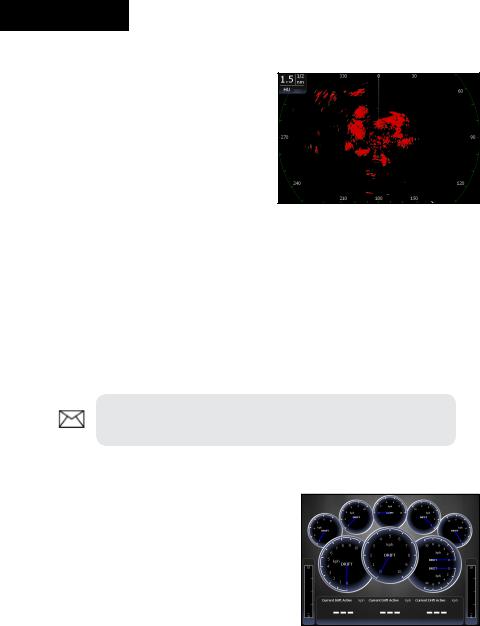
Pages
Radar Page
Displays the PPI (Position Plan Indicator) screen, Range Rings and the cursor.
The PPI can be shifted to show more of a desired portion of the screen (Look Ahead, Center & Offset) and the color palette can be changed to show returns in white, yellow, black or green. The radar page is covered in more detail in the Radar Operation section.
On the Radar Page you can:
•Overlay compass data, range rings and EBL/VRMs on display
•Choose screen orientation from Head Up, Course Up & North Up
•Make radar targets more visible via Target Expansion
Use the keypad to highlight Radar on the page screen and press ENTER to access the Radar Page.
NOTE: You will only be able to see the Radar page if your unit is connected to a radar.
Info Page
Consists of multiple gauges — Analog, Digital and Bar — that can be customized to display selected data. Customizing the info page allows you to monitor several types of desired data at the same time.
On the Info Page you can:
•Select data to be displayed in analog gauge or digital formats
•Change the page layout using one of three templates
•Select the range (scale) of analog gauges
To access the Info Page, use the keypad to select Info on the pages screen and press enter.
18
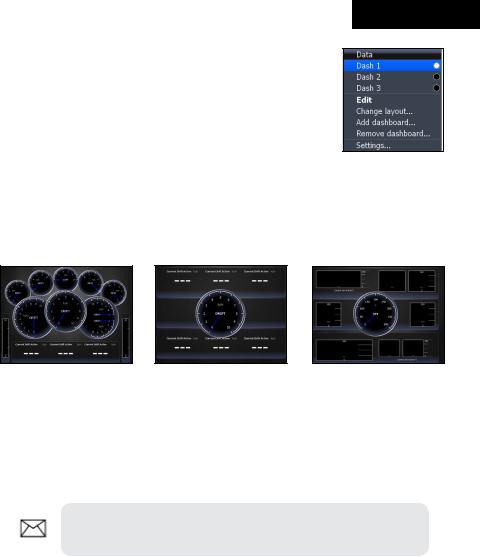
Pages
Data menu
Controls Info page data, page layout and data display format selection. To access the Data menu, press Menu while on the Info page.
Dash 1, Dash 2 and Dash 3 |
Data menu |
Info Page dashboard templates that vary in page layout and in the
number of gauges supported. The templates save you time by allowing you to use the Info page without having to manually set up a gauge layout.
Gauge Layout Templates
General Engine |
Digital Layout |
Bar Layout |
Layout |
|
|
You can change the gauge layout of Dash 1 (General Engine Layout), Dash 2 (Digital Layout) and Dash 3 (Bar Layout) templates using the change layout command. To select a dashboard template, highlight the desired template on the Data menu and press enter.
NOTE: You can toggle through the dashboard templates on the screen by pressing the keypad left/right.
Edit
Used to select information displayed on the Info page. To switch the screen to Edit Mode, select Edit from the Data menu and press enter. The active gauge will be shaded in blue (analog) or surrounded by a blue border (digital and bar).
19
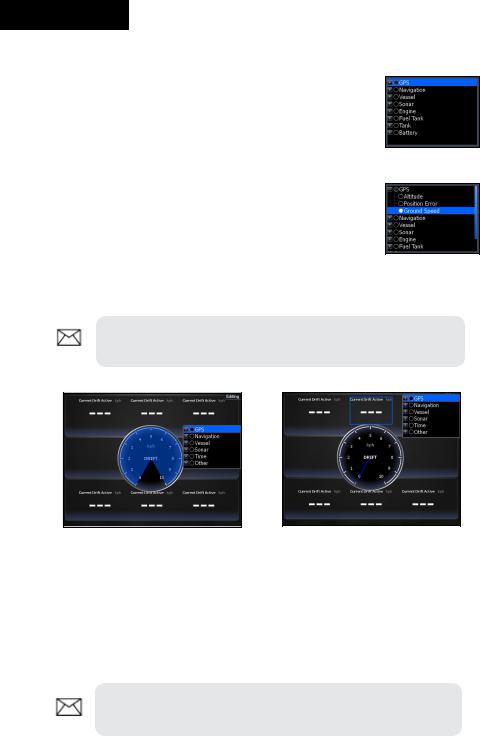
Pages
To edit gauge display:
1.Use the keypad to select the gauge you want to edit and press enter. The Select Data menu will appear.
2.Use the keypad to select a data category and press enter. A list of subcategories will appear.
3.Select the desired subcategory and press enter.
4.Press Menu. The Edit Data menu will appear.
5.Highlight Finish Edit and press Enter. The
Finish Edit Data menu will appear.
6.Highlight the Save button and press enter.
GPS category
Ground Speed
subcategory
NOTE: Press Enter or exit to switch gauges into Edit Mode to Normal Mode.
Editing data on an analog |
Editing data on a digital gauge |
gauge |
|
Edit Data menu
Changes Info Page gauge data, allowing you to display desired data on analog , digital and bar gauges. It also controls gauge limits.
To access the Edit Data menu, switch the screen to Edit mode and press menu.
NOTE: Select Data, Add Source and Configure Limits are described in more detail in the previous Data Overlay segment.
20
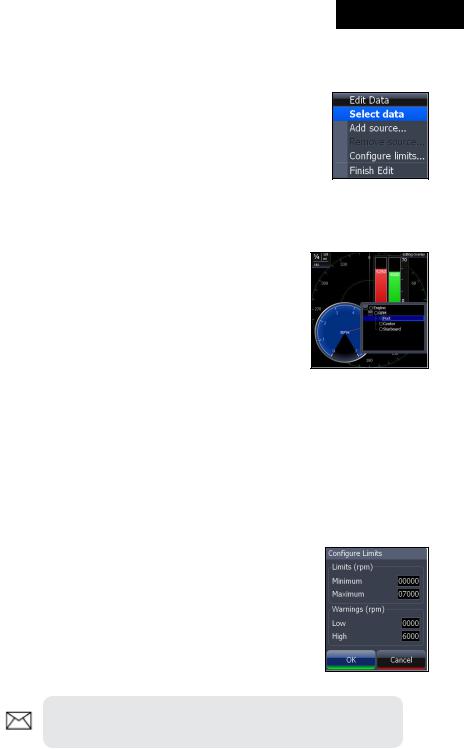
Pages
To select data:
1.Highlight Select Data from the Edit Data menu and press enter. The Select Data menu will appear.
2.Use the keypad to select the desired category and press enter. A list of subcategories will appear.
3.Select the desired subcategory and press enter.
To add source:
1.Select Add Source from the Edit Data menu and press enter.
2.Use the keypad to select the desired category and press enter. A list of subcategories will appear.
3.Select the desired subcategory and press enter.
To remove a source:
1.Highlight Remove Source from the Edit Data menu and press enter. The Remove data-source window will appear.
2.Select the source you want to remove and press enter.
To Configure Limits:
1.Highlight Configure Limits on the Edit Data menu and press enter. The Configure Limits menu will appear.
2.Select the desired text box and press enter.
3.Use the keypad to enter the desired limit or warning threshold.
4.Select OK and press enter.
NOTE: The Limits portion of the Configure Limits menu will only be shown when configuring analog gauge limits.
21
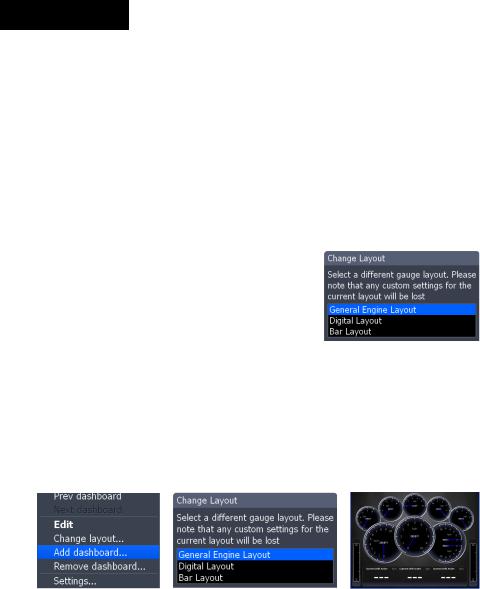
Pages
To Finish Editing:
1.Select Finish Edit from the Edit Data menu and press enter. A confirmation message will appear.
2.Select Save and press enter.
Change Layout
Controls the gauge layout of dashboard templates and customized dashboards. That allows you to select a desired gauge layout template for all dashboards.
To change layout:
1.Highlight the desired dashboard and press enter.
2.Select Change Layout from the Data menu and press enter.
3.Use the keypad to choose a gauge layout template and press enter.
Add Dashboard
Allows you to customize and save multiple dashboard templates. Desired data can be added to the gauges on each dashboard, allowing you to create custom dashboards for a variety of fishing conditions.You can even use the same gauge layout template for each dashboard.
When you have created all desired dashboards, press the keypad left/right to toggle through your dashboards.
To add a dashboard:
1.Select Add Dashboard from the Data menu and press enter. The Change Layout menu will appear.
2.Select the desired gauge layout and press enter. Refer to the previous Edit segment to customize the dashboard.
22

Pages
To remove dashboards:
1.Select the number of the dashboard you want to delete from the numerical dashboard list.
2.Highlight Remove Dashboard and press enter.
A confirmation message will appear.
3.Select Delete and press enter.
Settings
Numerical dashboard list
Opens the Settings menu. Settings information is covered in detail in the Settings menu section.
Utilities
Allows you to set alarms, view sonar logs and access other system settings.
To access Utilities:
1.Use the keypad to center the utilities icon on the screen.
2.Scroll down the list of utilities until the desired
option is highlighted. |
Utilities Icon |
|
|
3. Press ENTER. |
|
|
Utilities |
|
Waypoints, |
Access Waypoint, Route and Trails screen; covered in |
|
Routes/Trails |
the Chart Operation Section |
|
|
|
|
Find |
Search for POIs, Vessels, Coordinates,Trails, Waypoints |
|
and Routes; covered in Chart Operation Section |
||
|
||
Alarms |
Access alarm history, status and change settings |
|
Vessels |
View status and messages from vessels in the area |
|
Sun/Moon |
Displays time when sun and moon will rise/set |
|
Trip Calculator |
Keeps running tally/total of engine hours |
|
Files |
Access, copy and delete data files and sonar logs |
23

Pages
Copying a screenshot |
Copy File screen |
To copy data files/sonar logs:
1.Highlight Files from the Utilities menu and press enter.
2.Select the desired File category and press the keypad to the right. A list of subcategories will appear.
3.Select a subcategory and press the keypad to the right. Highlight the desired data file/sonar log.
4.Press Menu. Highlight Copy and press enter. The Copy File screen will appear.
5.Select a place to copy the file, like an MMC card. Press enter.
To delete data files/sonar logs:
1.Highlight Files from the Utilities menu and press enter.
2.Select the desired File category and press enter. A list of subcategories will appear.
3.Select a subcategory and press enter. Highlight the desired data file/sonar log. Copy and Delete buttons will appear at the bottom of the screen.
4.Select the Delete button and press enter. A confirmation message will appear.
5.Select Yes and press enter.
24
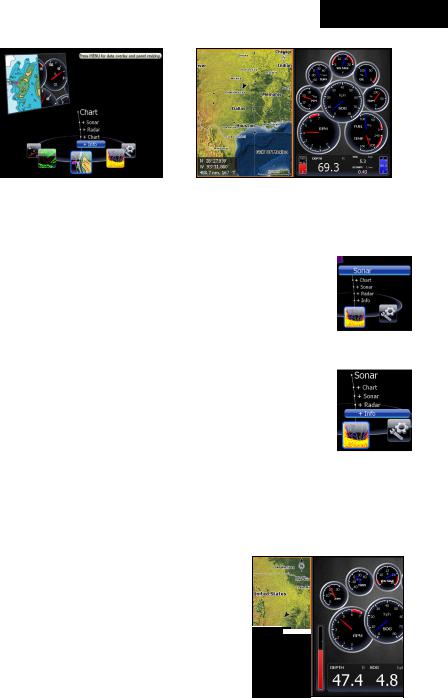
Pages
Info selected as combo |
GPS/Info combo page |
display option |
|
Displaying Combo Pages
You can display multiple pages at the same time by scrolling the desired page’s icon to the center of the screen and then choosing a secondary page from the list of combo page display options.
To display a combo page:
1.Use the keypad to select the first page for the combo display. This is the primary page, which will be displayed in the left panel.
2.Select another page from the primary page’s combo display list. This is the secondary page. It will be displayed in the right panel.
3.Press Enter. The selected combo page will be displayed.
Primary page
Secondary
page
Selecting an Active Page
When combo pages are displayed only one panel can be active at a time. The panel outlined with an orange border is the active page. You will only be able to access the context menu of the active panel. Pressing the Menu key will open the active panel’s context menu.
To switch the active setting to the other panel, hold down the Pages key for 1 second.
Chart panel is active as shown by the orange border
25
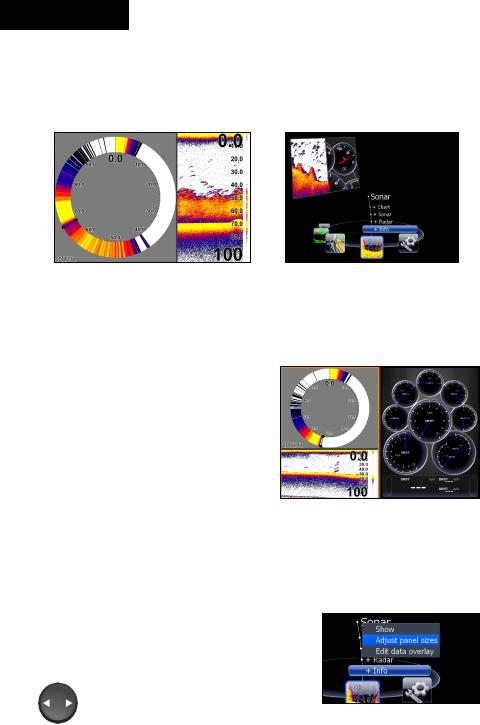
Pages
Displaying Multiple Panels
Multiple panels can be displayed by setting up a combo display using a page that supports the Split feature. By displaying multiple panels, you can view more information on the screen at one time.
Step 1: Select sonar split screen |
Step 2: Choose page from |
|
combo display options list |
To display multiple panels:
1.Select a Split view for the sonar page. (Accessing the Split feature is covered in detail in the Using
your Sonar section.)
2.Press the Pages key and use the keypad to center the Sonar icon on the screen.
3.Use the keypad to select Info
Page from the combo page display list. Press Enter. The
combo page will be displayed with the Sonar split view on the left; the Info page on the right.
Flasher, normal sonar and the info page shown on a multi-panel display.
Adjust Panel Sizes
Controls the size of panels when combo pages or multi-panels displays are in use. Adjusting the size of the panels, allows you to emphasize the panel you want to see more clearly.
Panels can only be adjusted left/right, so the panels on the side with the split view can not be adjusted vertically.
Adjust panel sizes selected on the Data Overlay menu
26
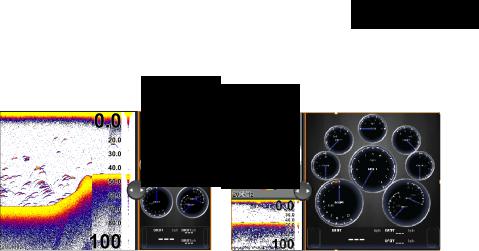
Pages
Moving panel cursor left/right will change the size of each panel
|
|
|
|
|
|
|
|
|
|
|
|
|
|
|
|
|
|
|
|
|
|
|
|
|
|
|
|
|
|
Adjusting panels on combo page |
Adjusting panels on multi-panel |
||||
|
|
|
|
|
display |
To adjust panel sizes:
1.With the combo page or multi-panel display on the screen, press the Pages key.
2.Press menu. Highlight Adjust Panel Sizes from the Data Overlay menu and press enter.
3.Press the keypad left/right to adjust the panels to a desired size and press enter.
27

Pages
Blank page
28
